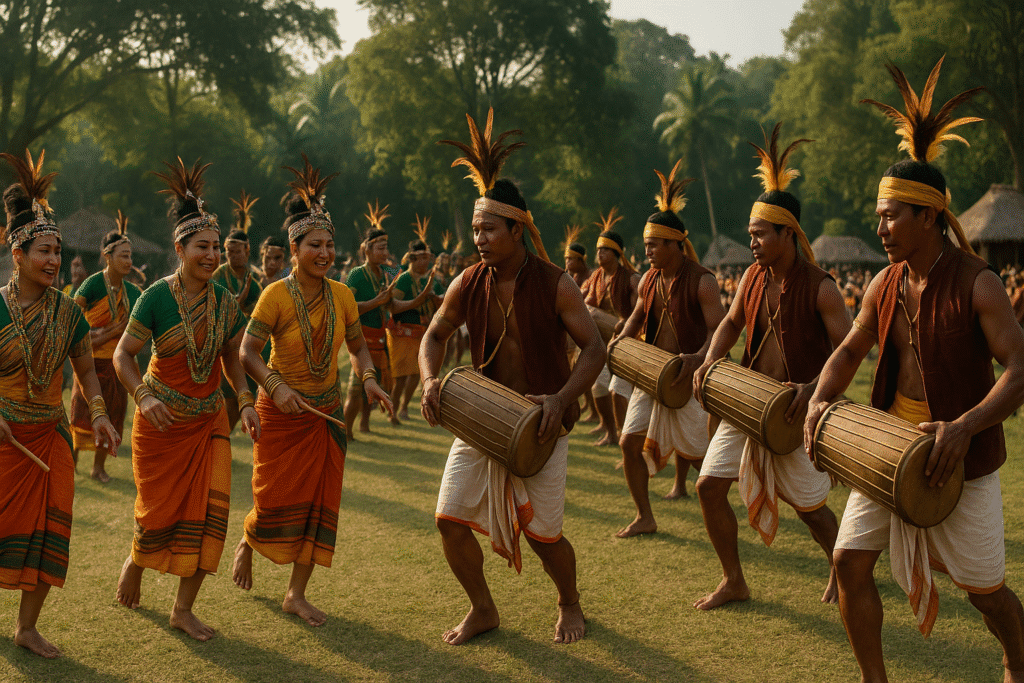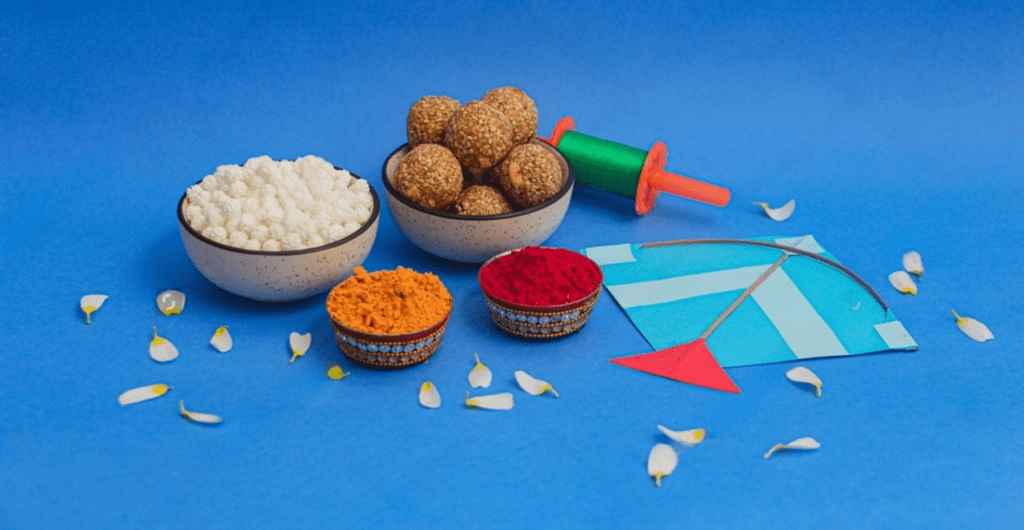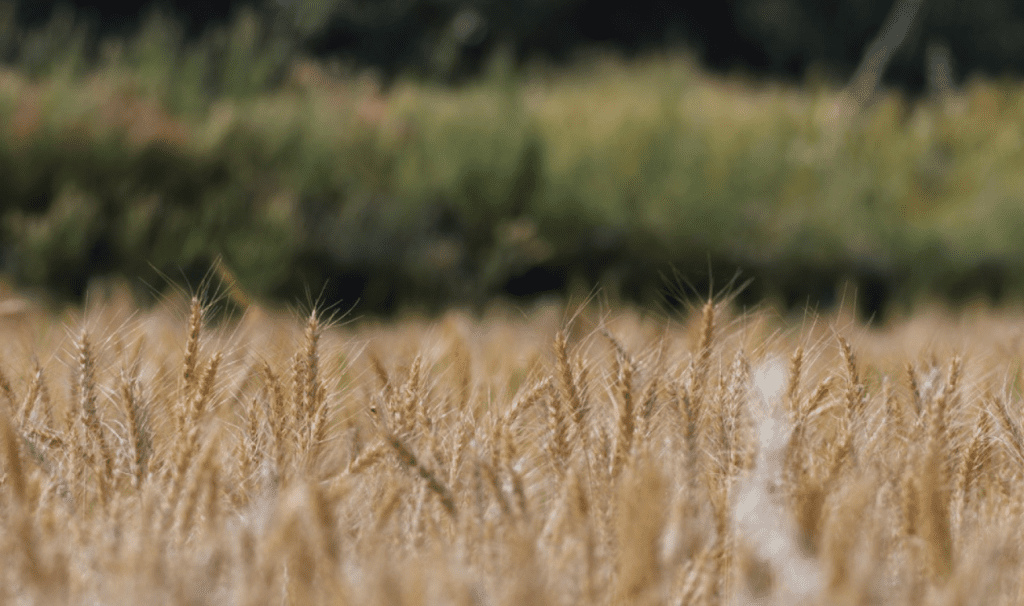Introduction: A Celebration of Harvest and Identity
Wangala, fondly known as the “100 Drums Festival,” is the vibrant harvest festival of the Garo tribe, celebrated with unparalleled zeal in Meghalaya, India, and parts of Assam, Nagaland, and Bangladesh. This post-harvest thanksgiving honors Misi Saljong, the Sun God, for blessing the land with a bountiful yield. Held annually in November, Wangala is a dazzling showcase of Garo culture, featuring rhythmic drumming, traditional dances, and communal revelry. Rooted in ancient animistic traditions, the festival not only marks the end of agricultural toil but also serves as a powerful expression of tribal identity and unity. This article delves into the history, rituals, cultural performances, and modern evolution of Wangala, painting a vivid picture of its enduring significance.
Historical Roots: A Legacy of Gratitude
Origins in Garo Animism
Wangala’s origins lie in the Garo tribe’s pre-Christian animistic beliefs, where Misi Saljong, also called Pattigipa Ra’rongipa (The Great Giver), was revered as the deity of fertility and prosperity. As an agrarian community, the Garos celebrated Wangala to express gratitude for the harvest, a tradition that predates the arrival of Christianity in the region. The festival’s rituals, such as offering rice beer and the first fruits, reflect a deep spiritual connection to the land and its cycles. Despite the influence of Christianity, Wangala remains a cultural cornerstone, especially in remote Songsarek (animistic) villages like Sadolpara in West Garo Hills.
The Birth of the 100 Drums Festival
The modern iteration of Wangala, known as the 100 Drums Festival, was formalized on December 6–7, 1976, in Asanang, near Tura, Meghalaya. Organized by the Hundred Drums Wangala Festival Committee, this state-sponsored event consolidated traditional celebrations into a grand platform to promote Garo heritage and attract tourism. Over the years, it has grown into a regional spectacle, drawing performers from Garo Hills, Bangladesh, and Karbi Anglong, while preserving the festival’s core rituals. The 48th edition, held from November 7–9, 2024, at Chibragre near Tura, exemplified its global appeal, with tourists from Germany, Switzerland, and beyond joining the festivities.
Rituals: Honoring the Sun God
Rugala and Cha’chat So’a: Sacred Beginnings
Wangala commences with the Rugala ceremony, performed by the Nokma (village chief or chieftain’s husband in the matrilineal Garo society). Inside the Nokma’s home, the priest, known as the Kamal, pours rice beer (Chu, fermented for seven years) and burns incense (Cha’chat So’a) to offer thanks to Misi Saljong. These rituals, accompanied by cooked rice and vegetables, symbolize gratitude for the harvest. The beating of the rang (traditional gong) follows, signaling the start of communal celebrations. These acts, steeped in animistic tradition, remain central to Wangala, even in modern iterations.
Offerings and Communal Bonding
The Garos offer the first fruits of the harvest, including rice and vegetables, to Misi Saljong, reinforcing their agrarian roots. The festival fosters community spirit through shared meals and the distribution of Chu and local delicacies like bamboo shoot curry and rice cakes. In traditional settings, Wangala spans two to seven days, with villages collaborating to host the event. The Nokma’s home serves as the spiritual and social hub, where rituals and merriment intertwine, strengthening tribal bonds.
Cultural Performances: The Soul of Wangala
The 100 Drums and Dama Gogata Dance
The heartbeat of Wangala is the rhythmic pounding of the cheng (traditional drums), often numbering 100 or more, giving the festival its iconic name. The Dama Gogata dance, performed on the final day, is a mesmerizing spectacle where men and women, adorned in vibrant attire, move in parallel lines. Men play drums, gongs, and bamboo flutes, while women, in bead-embellished chroko ganna wraps and kadesil headgear, sway to the beat. The dance mimics jhum (shifting cultivation) movements, from sowing seeds to harvesting, embodying the Garo’s agricultural heritage.
Traditional Dances and Indigenous Games
Wangala features a repertoire of folk dances, including Dani Doka, Ajia, Katta Doka, and Chambil Mesaa, each with unique rhythms and narratives. The Wangala dance, taught in schools like Christian Girls’ Higher Secondary School in Tura, is a cultural staple. Indigenous games like Budu Sala (tug-of-war), Ro’ong Dea (stone lifting), Makal Pala (wrestling), and Wapong Sika (bamboo pole pushing) add a competitive flair, engaging young and old. These performances and games, set against the backdrop of Garo Hills, create an electrifying atmosphere.
Traditional Attire: A Tapestry of Color
Garo Finery and Ornaments
Wangala is a visual feast, with participants donning traditional Garo attire. Women wear the ganna dakmanda (wrap), genji gisim (shirt), or pandra (crisscrossed cloth), accessorized with coral, shell, and silver ornaments. The kadesil headgear, adorned with feathers, adds regal flair. Men sport gantap wraps, dhotis, half-coats, and feathered turbans, exuding pride. These garments, often handmade, showcase the Garo’s craftsmanship and cultural identity, making Wangala a vibrant display of tribal aesthetics.
Preserving Craftsmanship
The intricate beadwork and weaving techniques used in Garo attire are passed down through generations, particularly in matrilineal households. Festivals like Wangala provide a platform to showcase these skills, encouraging younger Garos to learn and preserve their textile heritage. Homestays in Tura and nearby villages offer visitors a chance to witness this craftsmanship up close, deepening their appreciation of Garo culture.
Culinary Delights: Savoring Garo Flavors
Wangala is a culinary celebration, with traditional Garo dishes taking center stage. Visitors savor bamboo shoot curry, rice cakes, and nakham (dried fish) preparations, paired with the famous Garo rice wine, bitchi. The communal feasts, often prepared using local ingredients, reflect the Garo’s sustainable food practices. Food stalls at the festival, especially during the 100 Drums event, offer a taste of Meghalaya’s unique flavors, from tangy chutneys to hearty rice-based dishes, fostering a sense of shared joy.
Modern Evolution: A Global Stage
The 100 Drums Festival and Tourism
The 100 Drums Wangala Festival, held annually in the first week of November, has transformed Wangala into a global cultural event. Supported by the Meghalaya government, it attracts thousands to Chibragre or Wangala A’dam near Tura. The 2024 edition featured performances by regional bands like Riprap and Da Suraka at the Krimkro Music Festival, blending tradition with modernity. Tourists from Tamil Nadu, Pune, and international destinations enrich the event, while media coverage amplifies its reach. The festival’s inclusivity, with participants from Bangladesh and Tripura, underscores its role as a cultural bridge.
Balancing Tradition and Change
While the 100 Drums Festival is commercialized, traditional Wangala thrives in Songsarek villages, where animistic rituals remain untouched by Christianity’s influence. The festival’s anthem, “Dimdim Dimchong Dachichong,” composed by Late Millickson K Sangma, resonates across both settings, uniting generations. Efforts by the Wangala Committee and cultural bodies like the North East Zone Cultural Centre ensure the festival retains its authenticity while adapting to modern audiences, making it a beacon of Garo pride.
Wangala’s Broader Context
A Matrilineal Celebration
As one of the few matrilineal societies in the world, the Garos emphasize women’s roles in Wangala. Clan titles are inherited through mothers, and women lead in rituals and performances, reflecting their societal prominence. This unique structure sets Wangala apart from other harvest festivals like Bihu or Pongal, highlighting gender equity in tribal traditions.
A Regional Harvest Tapestry
Wangala shares parallels with other Northeast Indian festivals, such as Nagaland’s Hornbill Festival and Assam’s Bihu, all celebrating agricultural abundance. Its focus on the Sun God aligns with solar-based festivals across South Asia, like Makar Sankranti. However, Wangala’s distinct drum-driven dances and matrilineal context make it a standout, contributing to Meghalaya’s reputation as a cultural hotspot.
Conclusion: The Enduring Spirit of Wangala
Wangala is more than a festival; it is the pulsating soul of the Garo tribe, echoing through the hills of Meghalaya. From the sacred Rugala ritual to the thunderous beat of 100 drums, every element of Wangala weaves a story of gratitude, resilience, and cultural pride. As it evolves into a global celebration, the festival remains anchored in its animistic roots, bridging past and present. Whether in the intimate setting of a Songsarek village or the vibrant stage of Chibragre, Wangala invites all to join in its rhythm, savor its flavors, and honor the land’s bounty. As the drums fade, they leave behind a timeless message: to cherish heritage, community, and the gifts of the earth.



